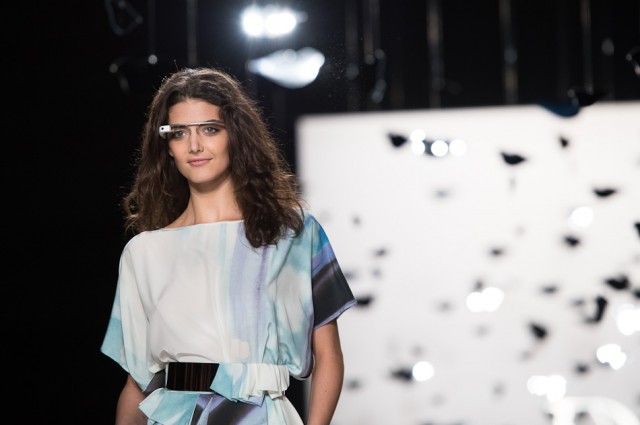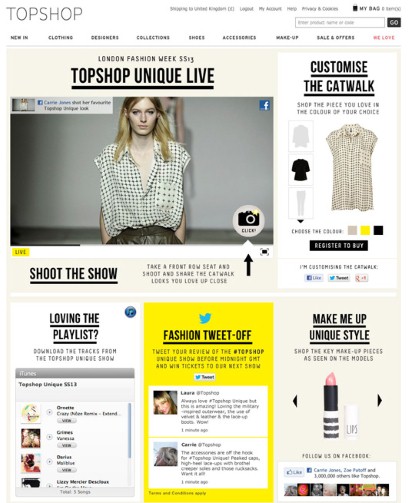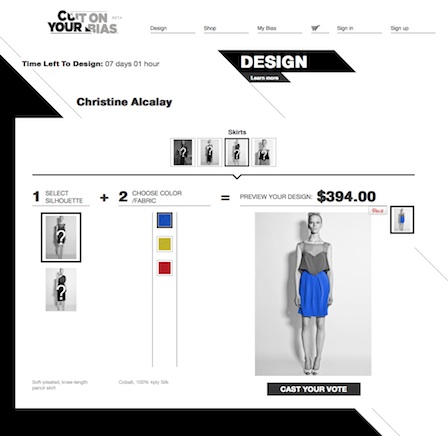The article is written by Laura Tan, Strategy Director, Digit
Ever since Diane Van Furstenberg’s S/S show surprised everyone with the debut of Google Glass, the most recent crop of Fashion Weeks both here and Stateside have been hailed as the most digital editions yet.
Photo: Google Glass at Diane Van Furstenberg’s S/S show
Here at Digit, we’ve picked out the five must-have digital trends from Fashion Week
1. Inclusivity
By definition, social is largely around inclusivity and Topshop in particular led the way in terms of opening up the once-heavily guarded gates of Fashion Week through livestreaming
Creating its ‘most advanced, immersive and engaging” social experience, Topshop partnered with Facebook to deliver the show to over 2 million people in over 100 countries. Justin Cooke, chief marketing officer at Topshop, described it as “social entertainment” and for a LFW challenger brand such as Topshop, it generated thousands of rich conversation high levels of interaction—particularly in markets where the brand is emerging.
Elsewhere, designer Jonathan Saunders teamed up with Motilo.com for an exclusive partnership that saw his show live-streamed on the site, as well as offering fans a chance to pre-order new pieces as soon as they were seen on the runway.
Photo: A snapshot from the Topshop.com website
2. Social Fashion
Analytics firm Precise were quick to brand this year’s LFW as the ‘most social yet’, and Burberry were one of the big winners with over 21,000 mentions compared to a mere 10,000 of second-placed Topshop. However, it becomes more interesting when you investigate how celebrities and the vaunted front row attendees influenced those conversations. For examples, Harry Styles was mentioned in a staggering 33percent of all tracked tweets for the entirety of Fashion Week.
With more than double the amount of tweets than the previous year, it’s clear that the medium is continuing to grow at an astonishing rate—yet the celebrity factor suggests that these conversations may not be as valuable towards a longer-term strategy.
3. Backstage Passes
While live-streaming was all the rage this year, many brands looked to build connections with consumers by offering an insight into what went on behind the scenes as well. Google+ seemed keen to position itself at the heart of such activity with its Google Hangouts product being integrated at both Rebecca Minkoff’s and Tibi’s shows. Fashion platform Lyst teamed up with Teen Vogue’s Eva Chen to host and moderate backstage hangouts that gave hardcore fans a chance to interact live with designers in the build up to the show.
A really nice idea, although journalists noted that WiFi was notoriously bad at the venue, and streaming quality left a bit to be desired.
4. Crowd-sourcing
Continuing the theme of a more social, inclusive Fashion Week, several houses included elements of crowd-sourcing as a way of encouraging interaction with fans. Carlos Campos, Christian Cota, Timo Weiland and Suzanne Rae all partnered with voting design platform CutonYourBias.com, where which fans could vote for their favourites and see the most popular brought to life on the catwalk.
Ownership is an interesting element to Fashion Week that seems to have arrived naturally with the influx of social media, but it will be interesting to see if it is truly a lasting mechanic of engagement.
Photo: A snapshot from the CutonYourBias.com website
5. PR Stunts
Unfortunately, the phrase sounds negative in an arena crying out for digital innovation, but it was difficult not to come away from this season’s festivities without a sense that many brands were merely dipping their toes into the digital waters, rather than anything more substantial.
While it is encouraging to see brands experiment with digital, if the end goal is as short-sighted as column inches, then it’s a trick destined to be as short-lived as the trends on the catwalk itself.
Experimentation is fun, but by not weaving digital into longer-term, profit-driven strategies, tech innovation could fall off the agenda quickly. There’s vast potential for brands to create quality, interactive content that is connected to the actual business it promotes. Only then it opens the door for digital to transform the way brands promote and sell products for the better.
It certainly was an exciting Fashion Week in terms of digital and fashion coming together in never-before-seen ways. But the big question for us here at Digit is whether this digital experimentation is really here to stay – or merely just another seasonal trend…


